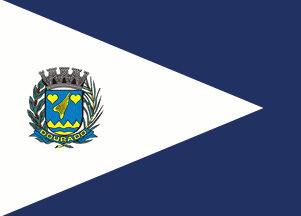 image by Dirk Schönberger,
22 October 2012
image by Dirk Schönberger,
22 October 2012Source: http://www.dourado.sp.gov.br/Pagina/Default.aspx?IDPagina=17

Last modified: 2012-11-04 by ian macdonald
Keywords: sao paulo | dourado |
Links: FOTW homepage |
search |
disclaimer and copyright |
write us |
mirrors
 image by Dirk Schönberger,
22 October 2012
image by Dirk Schönberger,
22 October 2012
Source:
http://www.dourado.sp.gov.br/Pagina/Default.aspx?IDPagina=17
A dark blue flag, with the municipal arms on a white triangle extending almost all across the flag from the hoist.
Official website at
http://www.dourado.sp.gov.br
Dirk Schönberger,
22 October 2012
Dourado was mentioned for the first time on 5 May 1856 on the book of records of the parish of Brotas. José Alves de Lima, born in São José das Formigas (today, Paraisópolis), Minas Gerais, wrote that "he has been owning the place called Dourado for more or less 26 years". In the 1830s, following the bust of gold in Minas Gerais, several miners left to yet unsettled regions. On 27 May 1856, Antonio José Vieira registered arable land located in Barrio de Dourado. Also in May 1856, Maria Francisca de Jesus, the widow of the miner Joaquim Pereira de Araújo registered lands located in Sitio de Dourado, on the bank of river Rio Jacaré-Pepira. Around 1880, Captain José Modesto de Abreu, one of the oldest colonists of the place, offered bare land located in Serra do Dourado to establish a new settlement. named São João Batista de Dourados. In 1891, the settlement, renamed Dourado, became the capital of a district, part of the municipality of Brotas. The municipality of Dourado was established on 19 May 1897.
The Companhia de Estrada de Ferro do Dourado (Douradense) was founded in 1900. The railway company was boosted by coffee cultivation, which peaked in 1920, when coffee was grown on 28% of the municipal territory by 60% of the landlords of the town. The Douradense built 300 km of railways to favour the export of coffee. At the time, the ton of Dourado counted 18,000 inhabitants. In 1930, the coffee bust reached Dourado, where it then covered 60% of the municipal territory. Coffee was progressively replaced by cotton and maize. In the 1960s, the railways, acquired by the Companhia Paulista de Estradas de Ferro, was suppressed, causing the leave of more than thousand railway workers.
The coat of arms, the flag and the anthem are listed, without further description, as the municipal symbols in Article 2 of the Municipal Constitution, last amended on 4 April 1990.
The symbols of Dourado are prescribed by Law No. 279 of 7 May 1980.
The flag is described in Articles 4-5 of the Law. The flag is rectangular, blue with a white triangle issuant from the hoist, charged with the municipal coat of arms. The proportions of the flag are 14 units x 20 units. The length of the triangle is 15 units, while the height of the coat of arms is 6.5 units.
The flag in use seems to have a gray fimbriation between the white triangle and the blue field. http://www.dourado.sp.gov.br/ImageBank/Galeria/17/9e27aa73-5cd1-45bf-b910-43853975fb7b_anivers_rio_Dourado_115_anos_081_653x490.jpg - Photo, 19 May 2012
The coat of arms, designed by Lauro Ribeiro Escobar, is prescribed in Articles 2-3 of the Law. "Iberic shield, azure a wing between two hearts all or, a base or serrated of four pieces a fess wavy azure. The shield surmounted by an eight-towered mural crown argent ports sable. The shield supported dexter by a branch of coffee and sinister by a sugar cane, the two leaved and fructed proper. Below the shield a scroll azure inscribed with the toponym 'DOURADO' in letters or'."
The Iberic shield, used in Portugal at the time of the discovery of
Brazil, evokes the first colonists of the country.
Azure (blue) represents in heraldry justice, beauty, sweetness,
nobleness, vigilance, serenity, constancy, incorruptible firmness,,
dignity, zeal and loyalty, characteristic of the inhabitants and of
the administrators of the municipality in their endless search for
progress.
The wing comes from the arms of the Abreu family, recalling that José
Modesto de Abreu offered the land where the municipality would be
established. The wing is the heraldic emblem of solicitude, diligence
and assiduity.
The hearts are symbols of courage, honor, affection, love, sincerity,
liberality and charity. They refer to the nickname of Dourado, "Heart
Town of São Paulo State".
Or means wealth, splendour, glory, nobleness, power, force, faith,
prosperity, sovereignty and rule, which are the aims aspired to by the
municipality and powered by its faith in God.
The fess wavy symbolize the watercourses of the municipality,
especially river Jacará-Pipira that attracts several fishers at the
end of each week.
The mural crown is the symbol of municipalities. The open gates
emphasize the hospitality of the inhabitants of the town.
The coffee branch and the sugar cane represent the soil fertility and
a main source of income.
Ivan Sache, 2 November 2012